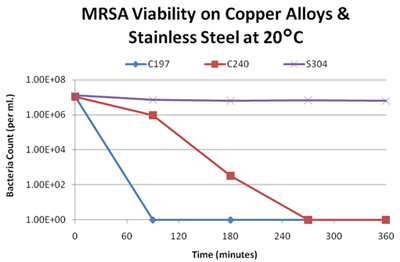Methicillin-resistant Staphylococcus aureus (MRSA)
MRSA infections are an increasing concern in healthcare facilities worldwide. Multi-drug resistant strains of this bacterium are easily transferred from patients and healthcare workers to touched surfaces and vice versa. Aside from transfer due to direct contact, MRSA can also be spread in an aerosolized form. The generation of airborne MRSA is largely caused by bacteria deposits found on the skin of infected patients. Contaminated skin cells are rubbed off from contact and can travel through the air. Bed linens can contain large amounts of MRSA infected skin cells which can be stirred up and transferred through the air when sheets are disturbed or changed. Airborne MRSA can be transported through HVAC systems and contribute to the spread of this infectious bacterium. Copper and copper alloys continuously kill MRSA. MRSA deposits cannot build up on copper surfaces like they can on other materials. The graph illustrates the survival of MRSA on several copper alloys and stainless steel for comparison. Copper alloys kill more than 99.9% of MRSA within two hours. The data clearly illustrates that stainless steel has virtually no effect on MRSA after 360 minutes.
 Note: C197, and C240 (brass) are both copper containing alloys. S304 is stainless steel.
Note: C197, and C240 (brass) are both copper containing alloys. S304 is stainless steel.Legionella pneumophila
This gram-negative bacterium can cause flu-like symptoms and eventually lead to pneumonia and even death. In 1976, an outbreak of pneumonia in an American Legion led to multiple deaths. The cause was later identified as Legionella pneumophila. The most prevalent form of Legionella transfer is via contaminated vapor droplets. Legionella can be found in hot water systems and collection pools found in air handling systems. Copper and copper alloys drastically reduce the ability of Legionella pneumophila to colonize on surfaces. Using copper in air handling systems can proactively hinder the primary transport method of this harmful bacterium. The table below compares the amount of colonized Legionella pneumophila on different surface materials. The data illustrates copper’s superior ability to prevent colonization of Legionella pneumophila.
| Material | Maximum Colonization | Colonization Ratio | ||
|---|---|---|---|---|
| non-legionellae | L. pneumophila | non-legionellae | L. pneumophila | |
| Colonization units are 1000/sq. cm. The colonizatio ratio is the CFU of total microbial flora or legionellae recovered from each material compared with the copper data. | ||||
| Copper | 70 | 0.7 | 1 | 1 |
| uPVC | 1070 | 11 | 15.3 | 15.7 |
| cPVC | 1700 | 78.5 | 24.3 | 112.1 |
| Steel | 4900 | 450 | 70 | 642 |
